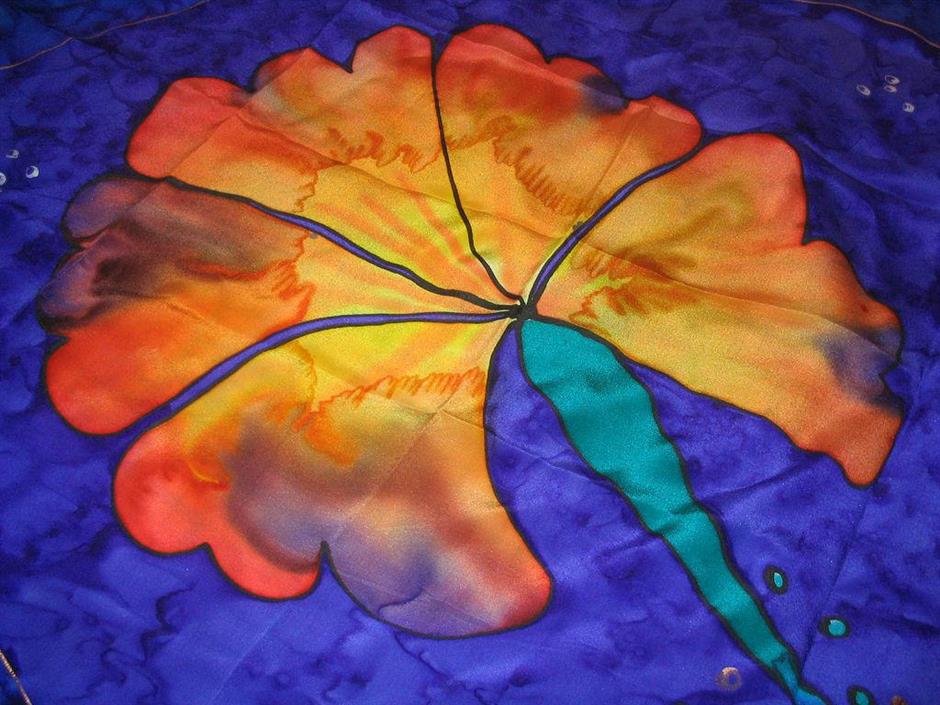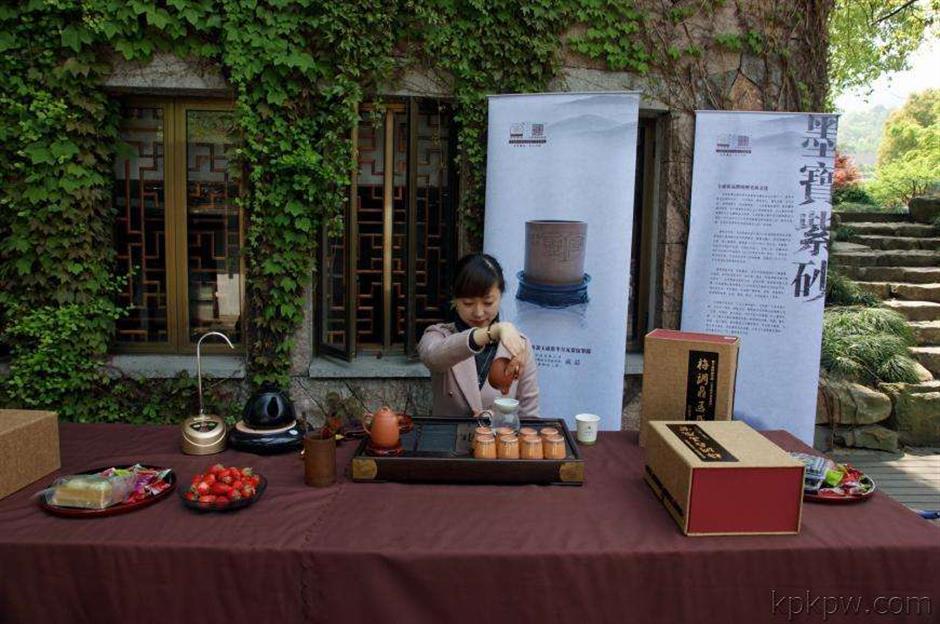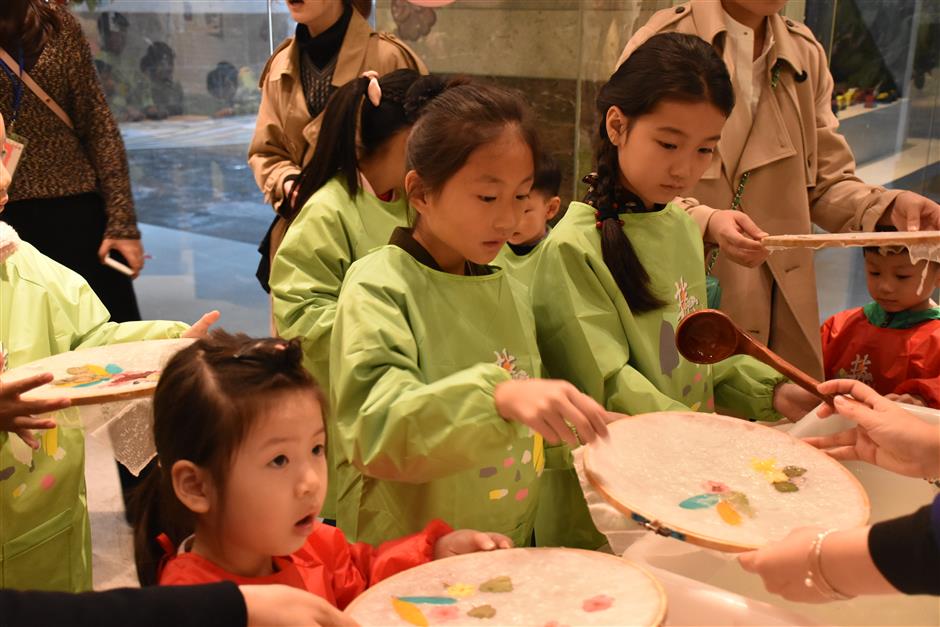Rediscover the city's historical past at its lesser known cultural havens
There are several specialized museums in Hangzhou, which may not be very well-known to outsiders but are as intriguing as the city’s more familiar historical places of interest.
As winter has set in and days out in the sun are few and far between, why not spend a weekend afternoon in a museum and enrich your cultural outlook?
There are three museums that have caught the eye of Shanghai Daily reporters.

Painting on silk is one of the educational programs offered by China National Silk Museum.
Try weaving and dyeing at the China National Silk Museum
The China National Silk Museum is the first national museum of its kind. Situated at the foot of Yuhang Hill, it is one of the world’s largest specialized museums on textile and clothing.
In 2015, the museum was redeveloped and reopened to public a year later with its exhibition area extended from 3,000 to 9,000 square meters.
The museum is composed of a research center, a brocade gallery that shows the history of Chinese silk weaving and a sericulture gallery which showcases the craftsmanship.
It was inscribed in 2009 on the Representative List of the Intangible Cultural Heritage of Humanity. It is also a fashion gallery that has recorded the transits in couture for the past hundreds of years.
The museum is also a good place to learn textile techniques of sewing, weaving and dyeing, and there are a lot of educational programs to offer. Among them is the Needlecraft Inheritance Institute.
In ancient times needlecraft was considered as a must-have skill for any girl who wants to get married. The institute, however, offers workshops that are open to all genders and invite lecturers from both the West and the East.
For example, in October this year, Edith Cheung, a costume designer and expert on clothing and textiles, hosted a six-day Master’s Class on Jacquard weave, which combines the theoretical studies and museum visits with hands-on practices.
There are also basic level classes designed for ordinary people, who had no knowledge of weaving and dyeing before. You can learn how to tie-dye, to paint on silk, to make a silk lantern, or even to work on a handloom.
Duration of classes vary from 40 to 120 minutes. And prices are also affordable at between 20 to 150 yuan (US$3 to US$23) each person with a finished piece of work included.
Address: 73 Yuhuangshan Rd
Admission: Permanent exhibitions are free. Educational programs need to be reserved and prices vary. For more information, please check en.chinasilkmuseum.com.

A tea ceremony preformed at China National Tea Museum
Sipping tea like a Chinese at China National Tea Museum
Built against Jiqing Hill, amidst the lush tea gardens, the China National Tea Museum has celebrated the history of tea sipping in China for more than 3,000 years.
The design of the museum borrows certain concepts from Chinese gardening, where galleries, pebbled paths, artificial mountains, lakes and waterside pavilions form the retreated ideal of the ancient Chinese literati.
The museum has two pavilions. The Shuangfeng (twin peaks) is used for exhibitions mainly, while the new Longjing is built on hills with its own tea gardens, tea toasting areas and spaces allocated for having a tea ceremony outdoors.
The permanent exhibitions are divided into several parts, each related to a different theme, such as the history of tea sipping, tea types, the processing of tea, teaware, and also traditions and customs in tea sipping.
Here you will be able to see tea samples excavated from the sunken Swedish East Indiaman’s ship, Götheborg in 1745. Or you can learn features and production areas of the six basic tea types in China, which are green tea, black tea, yellow tea, white tea, oolong and dark tea.
The tea ceremony performance is also a good option for first-time visitors.
For more advanced tea lovers, the museum offers a range of programs that helps you grow from a simple tea drinker to an appreciator of the world’s most popular drink and its culture.
The tea appreciation class, for example, focuses on the top 10 famous teas in China including, Longjing tea produced right in the place where the museum is situated. A 90-minute session, designed for four to six persons, will include knowledge on how to identify each type of tea, how to brew tea and drink tea properly.
Another highlight of the museum is its tea-picking event every spring.
Widely known that the best Longjing tea is always picked before the Tomb Sweeping Festival, which usually falls in early April each year. So it will be a good experience for non-tea drinkers to spend an afternoon outdoor, collecting one of the best gifts offered by nature in the warm breezes of Hangzhou.
Address: 88 Longjing Rd
Admission: Permanent exhibitions are free. Interactive programs are subject to reservation with prices varying. For more information, please check www.teamuseum.cn/default.aspx.

Children learn how to make handcrafted paper at Hangzhou Arts and Crafts Museum.
Make traditional Chinese crafts at Hangzhou Arts and Crafts Museum
Sitting beside the Grand Canal, the Hangzhou Arts and Crafts Museum was built in 2009 as part of the factory-turned museum cluster in Qiaoxi historical neighborhood.
It showcases several types of workmanship that used to be prominent in the area, including carving, ceramics making, weaving and embroidery and gold and silver jewellery making. There is also a section dedicated to folk craft products, such as the bamboo paper in Fuyang or jars for preserving Shaoxing wine.
On its second floor, visitors can observe how some craftworks were made by master craftsmen and artisans. Several of the artistry on offer is included in the national intangible cultural heritage list. And they face extinction if no one inherits the skills.
To promote and safeguard this folk art, which is also part of the local memory, the museum makes great efforts in engaging the general audience.
Visitors can reserve workshops for paper-cutting, umbrella painting, wood-carving and several other types of craftsmanship.
The workshop for making handcrafted flowery paper is the one that attracts the children. To produce such a piece of paper, the inner bark of some paper mulberry needs to be collected, which is used as raw materials.
After the process of drying, boiling, rinsing and softening, the bark is then torn into long pieces. The resulting fiber is screened and washed in water. The dried and flattened flowers are put onto the screen and cactus juice is used for gluing it on to the paper.
After drying for several hours, you get a beautiful piece of hand-made paper, which is exactly how the ancient Chinese have done it for thousands of years.
Address: 336 Xiaohe Rd
Admission: Permanent exhibitions are free. Tour guides and educational workshops can be reserved online. For more information, please check www.zgdjss.com.
















